Collecting Early Oak and Country Furniture, 1500-1800
The aim of this article is to give a brief overview of this area of the antique furniture market, and to show what to look for in the category and recent trends in the market. The market has changed noticeably in the last 25 years.
A small William & Mary joined oak and elm fully-enclosed dresser, circa 1700. Image: Bonhams
What is “Early Oak Furniture''?
What do we actually mean by the phrase `early oak and country furniture` ? Oak furniture is a catch all phrase for furniture made from the Tudor period, 1485-1603, through to about 1700. A serious collector would not countenance owning a piece from after 1700, so strictly speaking, the early oak period stops with the accession of Queen Anne in 1702. Most early oak furniture on the market dates from the 1620s-1700, covering the monarchs Charles I, Charles II and William and Mary. Elizabethan items are more thin on the ground and command strong prices, especially four poster/ tester beds. The below realised £32,000.
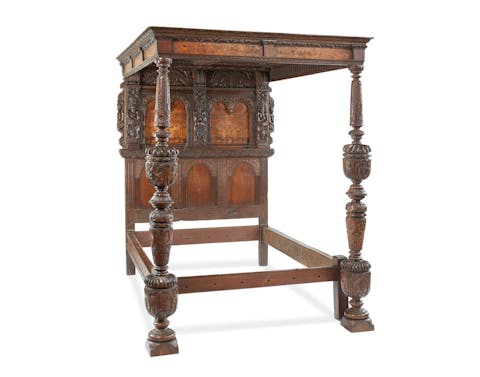
A rare and highly impressive Elizabeth I oak, walnut and marquetry inlaid tester bed, Southwark, London, circa 1585. Image: Bonhams
What is “Country Furniture”?
Country furniture is easier to define, and covers furniture made for regular day to day use in farms, taverns and country houses. The more sought after pieces have a primitive and rustic look. This furniture dates mainly from the 18th century and the first half of the 19th century. The more sought after pieces are usually from the 1750s to the 1800s. The very unusual George II primitive Windsor chair below, realised £14,000. A collector’s piece.
Check the latest Oak and Country furniture auctions at Barnebys here!
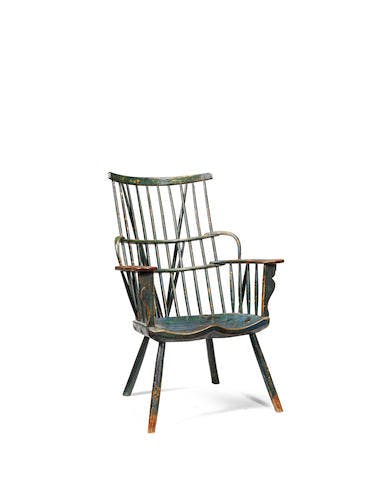
An exceptional large and elaborate George III painted oak and ash "primitive" Windsor armchair, attributed to the West Country, circa 1730-50, Image: Bonhams
This pair of Victorian mahogny wood Windsor chairs are less expensive, see below, they realised £1150 auction. They are good value furnishing pieces.
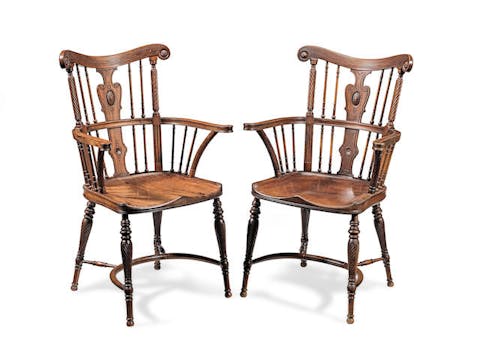
A pair of Victorian mahogany Windsor chairs, attributed to William Birch, Image: Bonhams
Oak and Country Furniture - What to look for?
So, what should you be looking for when buying early oak or country furniture? The two best places to buy from are auction houses with specialist sales or from reputable specialist dealers. They will guide you and you will be able to build up your own knowledge and eye. An enjoyable learning experience.
Original or “Married”?
Originality is a big factor especially with the 16th/17th century pieces. Many restorations and adaptations could have been made, many of which are themselves antique. Carving could have been added in the 19th century. Often 300 year old joined stools can have associated tops, namely a top from another Charles II stool has been recycled; so to speak. This is known as a `marriage.` Early panel back chairs often have replaced lower stretchers and later or associated seats. The following Henry VIII oak chest has an associated lid. It still made £2000, but would have realised more had the top been original.
Related: How to Value Antique Furniture
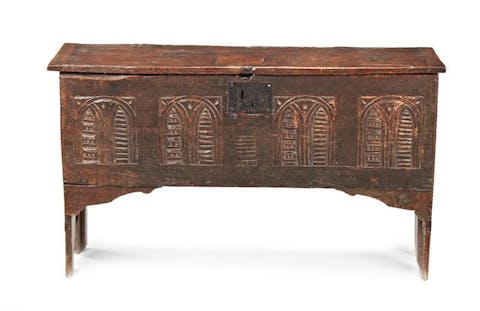
A rare Henry III oak boarded chest, with associated lid, circa 1520-40. Image: Bonhams
Oak cupboards can have been made in the 1820s out of timbers from the 1620s. A Victorian leg on a James I stool might drop its value from £3-5000 to £800-1200. There are of course out and out fakes to factor in. This can all sound a little daunting, so do take professional advice and always look out for signs of wear. Particularly with the pieces which were made for everyday use rather than display.
Restored Pieces
Smaller restorations however, are more understandable, and do not impair a piece's value hugely. For example tipping to the feet, replaced hinges, small replaced mouldings, things which are due to age and use. The earlier and rarer the piece, the more restorations are tolerated. Alterations less so. For example the rare James I stool below with an unusual base, had `top probably associated` in its description. It failed to sell against its estimate of £3-4000. Not quite a collector’s piece.
"Colour, patination and wear are key factors when deciding the value and collectability of an item. "
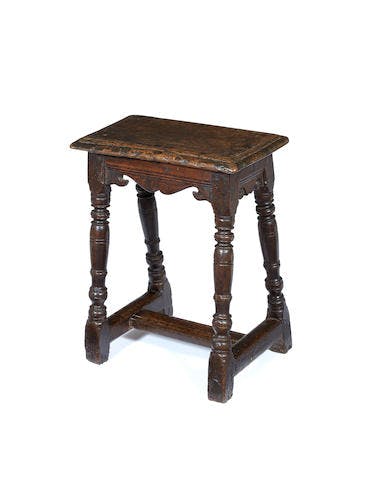
A James I/Charles I Oak joint stool, Taunton, Somerset, circa 1620 - 30. Image: Bonhams
Colour and Patination of wood
Colour, patination and wear are key factors when deciding the value and collectability of an item. Colour and patination overlap, but country woods such as elm, sycamore, fruitwood, ash and yew wood have great colours which can contrast and work very well together. Patination is the slow build up of layers of dust and wax polish and more dust and wax polish over a long period of time. This is difficult to fake. An item with a good patina will draw you towards it and you will want to touch it. This French late 18th century burr elm and fruitwood cupboard has a great colour. The burr wood door panels in particular. It was valued at £1000-1500.
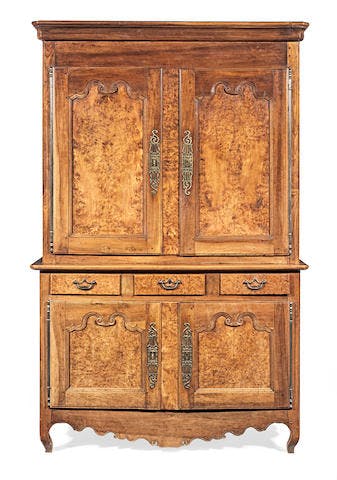
A late 18th century burr-elm and fruitwood buffet deux corps, French. Image: Bonhams
This light coloured sycamore cricket table below has that primitive look and a fabulous light colour and patina to it. It realised £1900.
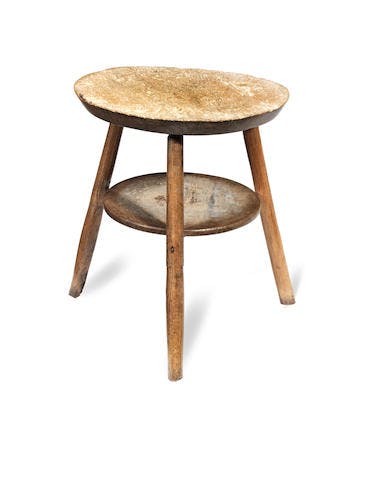
A George III sycamore two-tier primitive cricket table, circa 1800. Image: Bonhams
Wear is the sign of use which physically changes a small area of the piece. For example stretcher rails may have flattened, arms have worn down, incised decoration has been worn away, the original stained finish is worn back and edges feel soft and rounded.These three factors are the best of combinations in a piece, colour, patina and wear, and when you add authenticity you have a winning item. The chair below is a great example of wear, see the back panels, the arms and the edges of the back. They are lighter in colour and glow warm. It realised £6,000
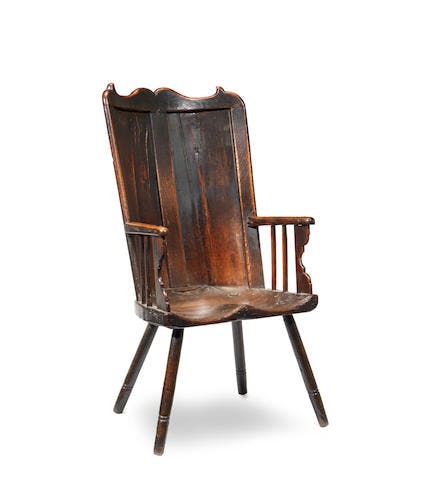
A rare and charming George II oak and probably sycamore panel-back primitive Windsor chais, Welsh Borders/ West Country, circa 1750. Image: Bonhams
The William and Mary panel back chair shows extreme wear to its front stretcher. A lot of serious use there! It realised £1800, despite a later seat. You can tell it is later as it is so uniformly flat and has no wear.

A William & Mary joined oak panel-back open armchair, Yorkshire, dated 1691. Image: Bonhams
"These three factors are the best of combinations in a piece, colour, patina and wear, and when you add authenticity you have a winning item."
Oak and Country Furniture Market Today
At the moment the oak and country market is very polarised into those rare top end collector’s pieces and furnishing items. Generally speaking people are still furnishing with country pieces as they have an informal shabby chic appeal. They are however furnishing a lot less with early oak pieces, which are generally darker and heavier in look. It is a great time to buy these early oak items as the prices are so low. Charles II coffers which 20 years ago were valued at £500-800 are now valued at £150-250, the same is true of 4 and 6 seater gateleg tables which hardly feature in specialised oak sales now, unless they are in a rare timber, like yew wood. The below example realised £1500. Great colour.

A solid yew-wood gateleg dining table, English, circa 1700. Image: Bonhams
At the moment Victorian windsor chairs are very buyable, they have fallen in price but not as seriously as the earlier pieces. A mixture of these can look great around an 1800s French farmhouse table. There is fun to be had in making up a set like this as well. English oak dressers are also a lot cheaper than they were. See below, this handsome George II dresser with an estimate of £1000-1500. It remained unsold. It would have sold easily for more than double this estimate, 10-15 years ago. A very buyable piece!

A George II joined oak enclosed high dresser, Snowdonia, circa 1730 - 60. Image: Bonhams
Collecting Furniture
The specialised Oak Sales which now take place, tend to focus on the earlier Elizabethan, James I pieces, the items the collector’s seek. Furniture is not an easy thing to physically collect, so collectors often focus on smaller items, namely joined stools, bible boxes or coffers. Plainer Charles II pieces, due to their fall in value, are now more often found in local general furniture sales. These are great places to go hunting in and bargains can be had. Always get an expert to talk you through a piece however. The following boarded chest, circa 1650,made £320 in a specialised sale, and only because of its small size and high feet. A good furnishing item.

A small mid-17th century oak boarded chest, English, circa 1650. Image: Bonhams
Where to Buy Antique Furniture?
So where to buy or look? The big three auction houses no longer have specialised Oak Sales, though Bonhams was dominant until very recently. Two auction houses which hold specialised sales are Wilkinsons in Doncaster and Bishop & Miller in Suffolk (England). There are specialised dealers around the Cotswolds and I would recommend trying the BADA and LAPADA websites. And of course, do go to salesrooms in your area.
It would be good to finish with some big hitting items from recent Oak Sales, items which truly are collector’s items, well, museum pieces really. They illustrate how the market has changed and how there is a lot less of a middle to the early oak market and to a degree, also to the country furniture market.
Pieces below, the unusual primitive table, 1840s, realised £7500 and the primitive comb back, 1800s, realised £4200. They both present super colour.

A good and highly unusual mid- 19th century naturalistic occasional table, English, circa 1840. Image: Bonhams

An interesting George III ash, primitive comb-back Windsor armchair, West Country, circa 1790. Image: Bonhams
The below pair of very rare James I oak chairs realised £22,000 against an estimate of £6000-8000. They are not flashy and do not scream money, but they tick all the early oak furniture boxes. The right wear, colour and authenticity but that elusive scarcity too. The Henry VIII 1520s cupboard is extremely rare and speaks for itself, realising £60,000 at auction.’
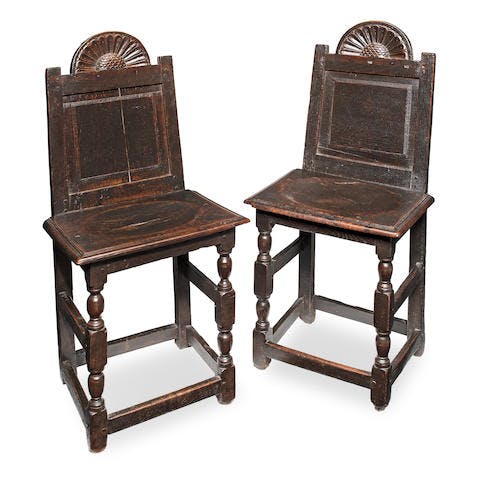
An extremely rare and documented pair of James I joined oak back stools, circa 1620. Image: Bonhams
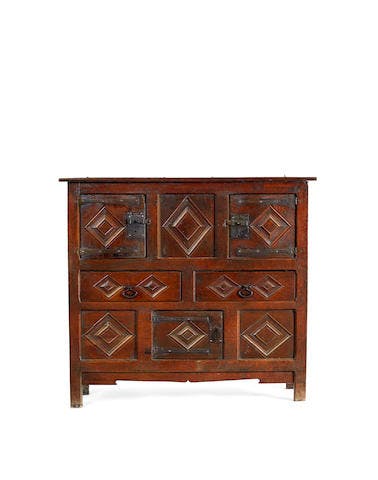
An exceptional and rare Henry VIII joined oak livery cupboard, circa 1520 - 40. Image: Bonhams
Unless you can afford the very best pieces, my advice is not to buy for investment, but buy items you feel drawn to and want to live with, and remember, always look for colour, patination and wear.
Start Your Appraisal of Oak and Country Furniture Here!
The author started working as a porter in a major auction house in 1994. He catalogued furniture from 1996 and was in charge of Oak and Country furniture sales until 2005, and oversaw the sale of several major collections. He has since worked for VMS, as a furniture specialist.

